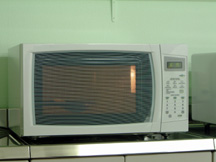
|
|
|||||
|
Sachiko's Guideline to Microwave Cooking
Facts You Need To Know

![]() Once
you try cooking with a microwave oven instead of just using it to warm up food, you will discover what a powerful cooking
tool it is. Because very little oil or water is used, the nutrients aren't removed from the food and the flavor isn't diluted.
Here are some useful tips and basic information for you to know before you embark on fast and easy, delicious and healthy
microwave cooking.
Once
you try cooking with a microwave oven instead of just using it to warm up food, you will discover what a powerful cooking
tool it is. Because very little oil or water is used, the nutrients aren't removed from the food and the flavor isn't diluted.
Here are some useful tips and basic information for you to know before you embark on fast and easy, delicious and healthy
microwave cooking.
[1]
Cooking time is approximate.
Check for doneness as you cook. Use a little kitchen thermometer to test the temperature of your food. Add more time if necessary.
The recipes presented on this website are based on 4 servings. Reduce the time and ingredients by half for 2 servings.
[2]
Know the wattage of your microwave oven
One of the most important factors in microwave cooking is, the cooking time. Make sure you know the wattage of your microwave oven.
It is usually listed inside the oven. Refer to this chart to estimate your cooking time.
< Cooking Time vs Wattage Conversion >
| Power of Microwave Ovens | ||||||||
| 1300W | 1200W | 1100W | 1000W | 900W | 800W | 700W | 600W | |
|
Cooking Time | 18:30 | 20:00 | 23:20 | 26:40 | 30:00 | 33:20 | 36:40 | 40:00 |
| 16:40 | 18:00 | 21:00 | 24:00 | 27:00 | 30:00 | 33:00 | 36:00 | |
| 14:50 | 16:00 | 18:40 | 21:20 | 24:00 | 26:40 | 29:20 | 32:00 | |
| 13:00 | 14:00 | 16:20 | 18:40 | 21:00 | 23:20 | 25:40 | 28:00 | |
| 11:10 | 12:00 | 14:00 | 16:00 | 18:00 | 20:00 | 22:00 | 24:00 | |
| 09:10 | 10:00 | 11:40 | 13:20 | 15:00 | 16:40 | 18:20 | 20:00 | |
| 07:20 | 08:00 | 09:20 | 10:40 | 12:00 | 13:20 | 14:40 | 16:00 | |
| 05:30 | 06:00 | 07:00 | 08:00 | 09:00 | 10:00 | 11:00 | 12:00 | |
| 03:40 | 04:00 | 04:40 | 05:20 | 06:00 | 06:40 | 07:20 | 08:00 | |
| 01:50 | 02:00 | 02:20 | 02:40 | 03:00 | 03:20 | 03:40 | 04:00 | |
| 00:30 | 00:30 | 00:35 | 00:40 | 00:45 | 00:50 | 00:55 | 01:00 | |
[3]
Microwaves cook from above.
 Unlike stove-top cooking that produces heat from underneath, the electromagnetic waves in a microwave oven penetrate food from above.
For this reason, thick and dense foods should be placed on top. When you cook spinach, for example, place soft leaves at the bottom
of a bowl and harder stalks on top.
Unlike stove-top cooking that produces heat from underneath, the electromagnetic waves in a microwave oven penetrate food from above.
For this reason, thick and dense foods should be placed on top. When you cook spinach, for example, place soft leaves at the bottom
of a bowl and harder stalks on top.
[4]
The golden rule: leave the center of the turn table empty

 Our natural tendency is to place food at the center of the turn table. However, the waves do not reach the center well and the food
does not cook evenly. Place food at the edge.
Our natural tendency is to place food at the center of the turn table. However, the waves do not reach the center well and the food
does not cook evenly. Place food at the edge.
[5]
Using a bacon rack eliminates the need to turn food

 The bottom of the food remains uncooked or cool when you microwave food. Place a microwave bacon rack under the food so the
electromagnetic waves can reach the food from underneath as well. You may also use a small microwave plate, a plastic lid, or
chopsticks.
The bottom of the food remains uncooked or cool when you microwave food. Place a microwave bacon rack under the food so the
electromagnetic waves can reach the food from underneath as well. You may also use a small microwave plate, a plastic lid, or
chopsticks.
[6]
It's weight, not size, that determines cooking time
 In stove top cooking, the smaller the pieces, the faster they cook. In microwave cooking, the total weight of the food determines
how fast the food cooks. Cut or a whole, it takes just as much time to cook.
In stove top cooking, the smaller the pieces, the faster they cook. In microwave cooking, the total weight of the food determines
how fast the food cooks. Cut or a whole, it takes just as much time to cook.
[7]
Microwave ovens cook food from within
 This is a basic factor in microwave cooking. To roast a chicken, microwave it first to cook the center of the chicken.
Then place the chicken in a conventional oven to cook the surface. This way, you avoid undercooking, and the chicken is roasted
quickly
This is a basic factor in microwave cooking. To roast a chicken, microwave it first to cook the center of the chicken.
Then place the chicken in a conventional oven to cook the surface. This way, you avoid undercooking, and the chicken is roasted
quickly
[8]
Microwaves love salt
 The salt on food attracts microwave energy. If you microwave pork tenderloin right after coating it with salt (before the pork's
water content comes to the surface), electromagnetic waves penetrate the meat through the salt. The meat becomes crisp and brown.
The salt on food attracts microwave energy. If you microwave pork tenderloin right after coating it with salt (before the pork's
water content comes to the surface), electromagnetic waves penetrate the meat through the salt. The meat becomes crisp and brown.
[9]
Timing is everything for defrosting uncooked food
 If the defrosting time is too long, it will begin to cook the food. Stop defrosting when it is half-thawed. For example, To
defrost frozen scallops, cover the turn table with a paper towel before placing scallops on top. Cook at LOW (30%) for 2-3 minutes
per 1/4 pound until half-thawed.
If the defrosting time is too long, it will begin to cook the food. Stop defrosting when it is half-thawed. For example, To
defrost frozen scallops, cover the turn table with a paper towel before placing scallops on top. Cook at LOW (30%) for 2-3 minutes
per 1/4 pound until half-thawed.
[10]
A rule of thumb for cooking foods together

 When cooking vegetables and meat together, place vegetables on the bottom and meat on top. Meat requires more cooking time.
Remember: microwaves come from the top.
When cooking vegetables and meat together, place vegetables on the bottom and meat on top. Meat requires more cooking time.
Remember: microwaves come from the top.
[11]
Some foods have natural wrappings
 Potatoes and apples are good examples. The potato skin works just like a plastic wrap. It traps the potato's taste and moisture.
Poke a few holes with fork tines to prevent the skin from bursting. Place the potato on a bacon rack so the microwaves can hit it
from underneath and the potato is evenly cooked. When cooking an egg, pierce the yolk with a toothpick or needle.
Potatoes and apples are good examples. The potato skin works just like a plastic wrap. It traps the potato's taste and moisture.
Poke a few holes with fork tines to prevent the skin from bursting. Place the potato on a bacon rack so the microwaves can hit it
from underneath and the potato is evenly cooked. When cooking an egg, pierce the yolk with a toothpick or needle.
[12]
Use alcohol for protein-rich ingredients

 Protein hardens when it is cooked at water's boiling point (212F or 100C.) Sprinkle wine over chicken breast before you steam it.
Add wine in the sauce when you cook fish. Wine lowers the boiling point and the food turns out softer and juicier.
Protein hardens when it is cooked at water's boiling point (212F or 100C.) Sprinkle wine over chicken breast before you steam it.
Add wine in the sauce when you cook fish. Wine lowers the boiling point and the food turns out softer and juicier.
[13]
Container placement

 Place the container at the edge of the turn table when cooking with one container. When cooking with two containers, place each at
opposite sides of the turn table.
Place the container at the edge of the turn table when cooking with one container. When cooking with two containers, place each at
opposite sides of the turn table.
[14]
Defrosting or reheating frozen cooked food

 The heating time for frozen cooked food will be shortened by stirring at the half-way point.
The heating time for frozen cooked food will be shortened by stirring at the half-way point.
[15]
A Cover is important in microwave cooking


 Use a microwave lid to cover food. It is vented and designed for microwave cooking. When using plastic wrap, poke a small hole
to vent the steam. When removing the lid or wrap, escaping steam will be Hot! Use caution! Using a lid when cooking food,
will also keep your microwave oven clean.
Use a microwave lid to cover food. It is vented and designed for microwave cooking. When using plastic wrap, poke a small hole
to vent the steam. When removing the lid or wrap, escaping steam will be Hot! Use caution! Using a lid when cooking food,
will also keep your microwave oven clean.
[16]
Use microwave compatible equipment

 There are microwave-safe utensils and those that are not suitable for microwave use. It is recommended, that if you enjoy cooking
with your microwave oven, you buy a good oven and the compatible cooking tools that are made for microwave cooking.
There are microwave-safe utensils and those that are not suitable for microwave use. It is recommended, that if you enjoy cooking
with your microwave oven, you buy a good oven and the compatible cooking tools that are made for microwave cooking.
Compatible:
Plastics
Glass and certain ceramics
Incompatible:
Metal
Certain ceramics
| <<Home |
|
|
| Recipes | About author | How to use microwave | Contact | |